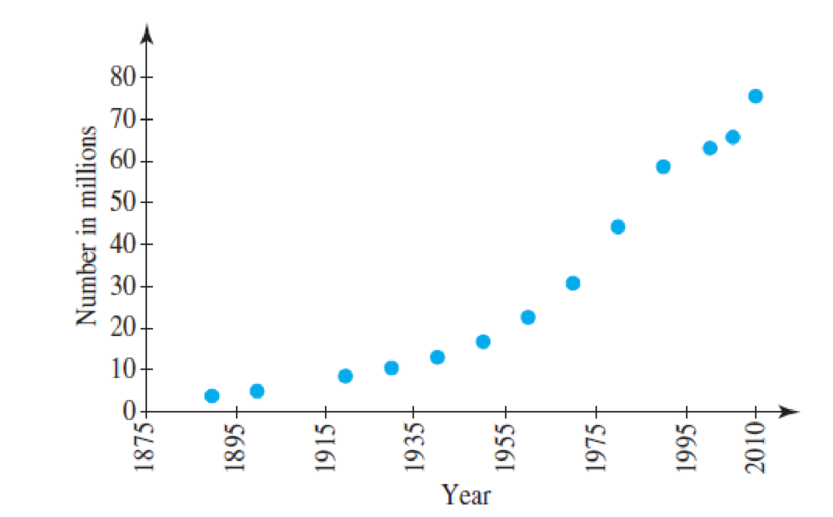
Concept explainers
Women in the Workforce The number of women in the workforce (in millions) for selected years from 1890 to 2010 is shown in the following figure.
a. Would the data in the
b. The number of women in the workforce was 10.519 million in 1930 and 16.443 million in 1950. What is the average rate of change in the number of women in the workforce during this period?
c. If the number of women in the workforce was 16.443 million in 1950 and 75.500 million in 2010, what is the average rate of change in the number of women in the workforce during this period?
d. Is it reasonable that these two average rates of change are different? How can you tell this from the graph?

(Source: Newsweek)
Want to see the full answer?
Check out a sample textbook solution
Chapter 1 Solutions
EBK COLLEGE ALGEBRA IN CONTEXT
- No chatgpt pls will upvotearrow_forwardDo the Laplace Transformation and give the answer in Partial Fractions. Also do the Inverted Laplace Transformation and explain step-by-step.arrow_forward18.9. Let denote the boundary of the rectangle whose vertices are -2-2i, 2-21,2+i and -2+i in the positive direction. Evaluate each of the following integrals: L₁ = 2- (a). dz, (b). (d). ₁ = 22+2 [ dz, (e). √, z COS 2 dz dz, (c). L (2z+1)2dz, z(z+1)' (1). [e² si 1 sin z+ dz. (22+3)2arrow_forward
- 4. The revenue (in thousands of dollars) from producing x units of an item is R(x)=8x-0.015 x². a) Find the average rate of change of revenue when the production is increased from 1000 to 1001 units.arrow_forwardMATH 122 WORKSHEET 3 February 5, 2025 . Solve the following problems on a separate sheet. Justify your answers to earn full credit. 1. Let f(x) = x² - 2x + 1. (a) Find the slope of the graph of y = f (x) at the point P = (0,1) by directly evaluating the limit: f'(0) = lim ( f(Ax) - f(0) Ax Ax→0 (b) Find the equation of the tangent line 1 to the graph of ƒ at P. What are the x and y intercepts of 1 ? (c) Find the equation of the line, n, through P that is perpendicular to the tangent line l. (Line n is called the normal line to the graph of f at P.) (d) Sketch a careful graph that displays: the graph of y = f (x), its vertex point, its tangent and normal lines at point P, and the x and y intercepts of these lines. Bonus: Find the coordinates of the second point, Q, (QP), at which the normal line n intersects the graph of f. 2. A rock is thrown vertically upward with an initial velocity of 20 m/s from the edge of a bridge that is 25 meters above a river bed. Based on Newton's Laws of…arrow_forward1 If ye y = sin x, find dy/dx and dy/dx² at (0, 0).arrow_forward
- 3. Use the graph for problem #35, p175 to answer the questions. The average price (in cents) per gallon of unleaded gasoline in the United States for the years 2010 to 2019 is shown in this chart. Find the average rate of change per year in the average price per gallon for each time period. Source: U.S. Energy Information Administration. a) 2010 to 2013 b) 2012 to 2018 c) 2014 to 2019arrow_forward4. Researchers at Iowa State University and the University of Arkansas have developed a piecewise function that can be used to estimate the body weight (in grams) of a male broiler during the first 56 days of life according to W(t)=48+3.64t+0.6363²+0.00963 t³ if 1St≤28, -1004+65.8t if 28arrow_forward3. Given the function h(x)=(x²+x-12 if x≤1 3-x if x>1' a) Graph the function h(x). Make the graph big enough to be easily read using the space below. Be sure to label all important aspects of the graph. b) Find all values of x where the function is discontinuous. c) Find the limit from the left and from the right at any values of x found in part b.arrow_forwardarrow_back_iosSEE MORE QUESTIONSarrow_forward_ios
 College Algebra (MindTap Course List)AlgebraISBN:9781305652231Author:R. David Gustafson, Jeff HughesPublisher:Cengage Learning
College Algebra (MindTap Course List)AlgebraISBN:9781305652231Author:R. David Gustafson, Jeff HughesPublisher:Cengage Learning College AlgebraAlgebraISBN:9781305115545Author:James Stewart, Lothar Redlin, Saleem WatsonPublisher:Cengage Learning
College AlgebraAlgebraISBN:9781305115545Author:James Stewart, Lothar Redlin, Saleem WatsonPublisher:Cengage Learning Algebra and Trigonometry (MindTap Course List)AlgebraISBN:9781305071742Author:James Stewart, Lothar Redlin, Saleem WatsonPublisher:Cengage Learning
Algebra and Trigonometry (MindTap Course List)AlgebraISBN:9781305071742Author:James Stewart, Lothar Redlin, Saleem WatsonPublisher:Cengage Learning
 Trigonometry (MindTap Course List)TrigonometryISBN:9781337278461Author:Ron LarsonPublisher:Cengage Learning
Trigonometry (MindTap Course List)TrigonometryISBN:9781337278461Author:Ron LarsonPublisher:Cengage Learning Glencoe Algebra 1, Student Edition, 9780079039897...AlgebraISBN:9780079039897Author:CarterPublisher:McGraw Hill
Glencoe Algebra 1, Student Edition, 9780079039897...AlgebraISBN:9780079039897Author:CarterPublisher:McGraw Hill





